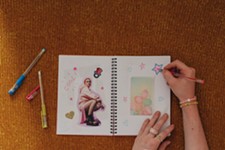The Brethren of Cisterns
What's Old Is New Again
By Robert Bryce, Fri., June 14, 1996
Of course, the king hadn't invented the idea; cisterns had been around for at least 2,000 years before he decided to chisel his orders in stone. Evidence of rainwater collection systems in Jordan dates back to at least 3,000BC. Cisterns are mentioned several times in the Old Testament. The prophet Jeremiah was imprisoned in a cistern by King Zedekiah. Joseph, the son of Jacob, got tossed in a cistern after his good-for-nothing brothers took his tunic. They later hauled him out only to sell him into slavery.
To this day, cisterns continue to be used in the Middle East. According to a scholarly paper presented in Finland last year, new homes in Amman, Jordan, are required to have cisterns. The paper also says that in 1921, some 7,000 cisterns were being used to collect rainwater in Jerusalem.
Here in Texas, cisterns are getting increased attention due to growing problems with surface and groundwater supplies. And of course, the drought has accentuated the need to find alternative water supplies. Originally, natural rainwater catchments in Texas attracted nomadic tribes like the Mescalero Apaches. At Hueco Tanks State Park near El Paso -- an area that includes several natural cisterns known as tinajas -- 10,000-year-old spear points have been recovered. When Anglos arrived, cisterns were among the first things they built. Austin has numerous antique cisterns. The French Legation, which was built in 1840 and is the oldest frame structure in Austin, has a cistern outside the kitchen. "The cistern was probably built in the 1880s after the springs on the property dried up," says the Legation's director, Diane Long.
Charlie Mackie, of the Heritage Society of Austin, says that cisterns were a critical source of water for Austinites after the 1937 flood contaminated the city's water treatment plant. Mackie said many residents used water from a cistern at the Smoot House, an historic house at 1316 W. Sixth that was built in 1877. He also says there was a 25,000-gallon cistern in the courtyard of the building that served as the temporary Capitol between 1883 and 1888.
Gail Vittori, of the Center for Maximum Potential Building Systems, is working on a book project for the Texas Water Development Board called Texas Guide to Rainwater Harvesting. Her research has found dozens of cisterns in Fredericksburg, some more than 100 years old. Many homes had a well and a cistern; the well water was used for livestock and washing, while the rainwater was used for cooking and drinking. There's even a settlement called Cistern, in Fayette County, a few miles southwest of La Grange.
Vittori's project is one of many efforts being pursued across Texas that are part of the renaissance of rainwater collection. In the Austin area alone, more than half a dozen vendors are selling cisterns and/or rainwater collection systems. The tanks can be made of concrete, steel, fiberglass, or several other materials. And as the drought continues, interest appears to be increasing. Richard Heinichen, the "mayor" of Tank Town, a Dripping Springs-based company that sells fiberglass cisterns, says his business has been steadily increasing over the past few months. Heinichen and his wife, Chronicle writer Suzy Banks, have been living off of rainwater for over two years.
Last week, Heinichen sold a fiberglass cistern to a customer who lives northwest of Dripping Springs, whose well -- drilled to more than 450 feet -- went dry. "They could drill the well to 1,400 feet or spend that same money on a rainwater program," said Heinichen, who estimated that they could install a 10,000 gallon cistern and all the other equipment they need to collect rainwater for about $6,000. "I encouraged them not to put any more money into their well. They could easily make it on rainwater."
The renaissance of cisterns in Texas is being paralleled by activities in other parts of the world. A team of American anthropologists is now working in Jordan to refurbish ancient cisterns that have fallen into disrepair. As the water politics of the Middle East grow increasingly strained, cisterns are providing a low-cost way to provide drinking water for large segments of the population.
Cisterns and rainwater catchments are now mandatory in new construction in the U.S. Virgin Islands and Bermuda. The state of California offers tax credits for cisterns. The Environmental Protection Agency recently estimated that there are now some 200,000 cisterns in use in this country. Japan and Germany offer financial incentives for rainwater collection. The World Bank is financing the construction of cisterns in China and Egypt.
Vittori says that cisterns allow people to be independent. "Yes, you can have a well today," she says. "But the potential that the well can be contaminated or the water supply can diminish, both are out of your control. I think it's definitely a self-reliance thing."
There's lots of info available on rainwater collection. If you have access to the World Wide Web, go to the City of Austin's green builder home page at http://www.greenbuilder.com/Sourcebook/Rainwater.html#NET, or to the Austin Chronicle's green building page at /green/. Also, call the city's Green Builder program at 499-7827, or pick up the Texas Water Development Board (463-8176) Guide to Rainwater Harvesting book this fall.
Got something to say on the subject? Send a letter to the editor.








